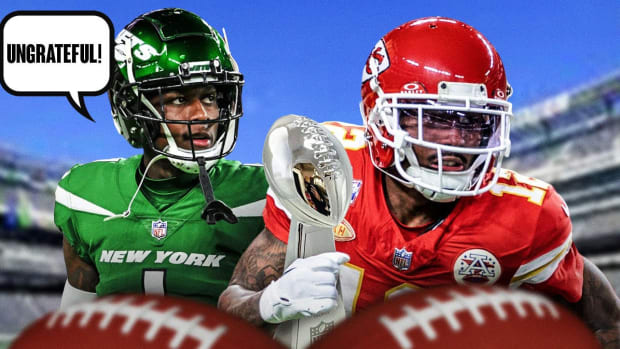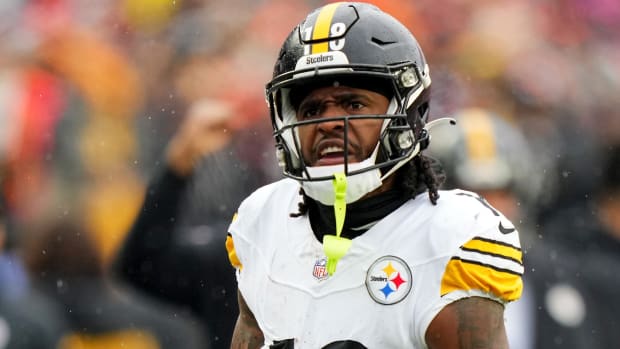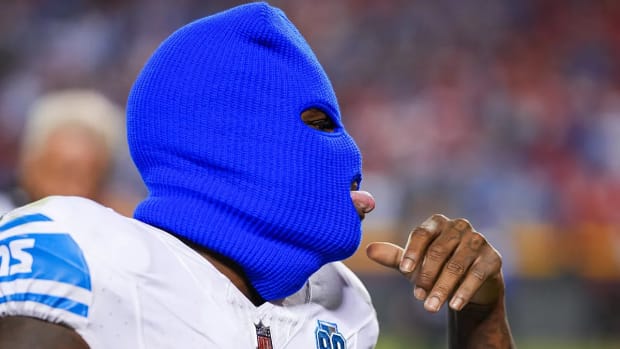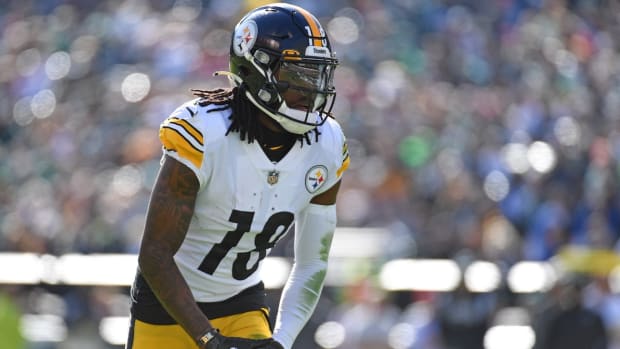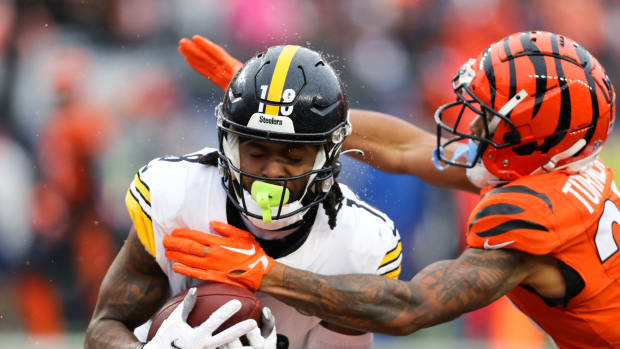Speed, Discipline and a Whole Bunch of Cash: Inside the Odd Sale of the Carolina Panthers
Word around the NFL campfire over the last five months indicated outgoing Panthers owner Jerry Richardson was eyeing two things for his exit.
One, he wanted to find a native Carolinian to buy the franchise he founded in 1995. Two, he wanted to fetch somewhere in the $2.6 billion range for this asset that in essence he had to be coerced into selling in the wake of Jon Wertheim’s explosive Dec. 17 story on the workplace environment in Charlotte.
This morning, Richardson finds himself 0-for-2.
Next week in Atlanta, the NFL will approve (it’s a formality) hedge fund manager and Steelers minority owner David Tepper’s purchase of the league’s 29th franchise. In making it official, Richardson and the NFL will walk away from the high bidder, credit card magnate Ben Navarro, who was both a lot closer to Richardson’s target price and a resident of Charleston, S.C.
Confused? As team sales go, this was a weird one. The pro sports franchises that have most recently sold went for eye-popping rates, way over what was expected. And this one didn’t, which is a little disappointing for Richardson, and for the NFL, no matter they might say publicly.
A total loss, it’s not. But things didn’t exactly go according to plan.
In this week’s Game Plan, we’ll explain why the NFL is planning to take a different path than the NBA or MLB on gambling, give an update on the Jon Gruden/Derek Carr relationship, give you a little bit on Odell Beckham, explain how Tony Romo is still dishing off to Jason Witten and show you how the role of the coaches in league matters is expanding.
But we’re starting with the Panthers changing hands, the weird way it happened and what it means for the NFL going forward.
With David Tepper Buying the Panthers, Donald Trump Faces More NFL Resistance
“The only thing I can think of here it’s that it’s gotta be disappointing for the league and for the other owners,” said one source who was involved with a bid. “You look at what the [NBA’s] Nets and Rockets went for, and this is a high-profile East Coast team, and it didn’t turn into an auction the way these things usually do.
“Tepper’s always been super disciplined, and he told the world he was going to be super disciplined on this one, and he waited them out and won. There has to be some lingering uneasiness over that.”
Two months ago in Orlando, the lack of discussion of the sale caught the attention of team owners and executives. In the cases of Los Angeles and Las Vegas, it was the opposite. There was owner-to-owner politicking, there was debate in the room, there were alliances formed over time. The process of picking projects, picking teams, and setting relocation fees was out there for those in the NFL’s inner circle.
To be fair, those situations involved franchise moves and, in the Raiders’ case, gambling; they were more complicated. That said, the Panthers’ sale wasn’t even addressed in the general session in March, and was only broached at a surface level during the privileged sessions that are limited to owners and their kin.
So what does that mean? As one team exec explains it, “Anything where it’s as quiet as it was, things are messy, and usually there’s a lot of backdoor dealing and politicking. With this one, no one wanted to go on the record.”
There are reasons why, according to a handful of those we spoke to over the last 48 hours that were in those rooms and have knowledge of these matters.
One, the deal may not have needed to happen quickly, but that was absolutely the preference of the league and other teams. The next meeting after next week is in October, so missing the window this time could cause things to get considerably messier. The investigation would continue, of course, and the NFL likely would’ve had to suspend Richardson at the beginning of the 2018 season.
Related to that, Tepper’s capital and background allowed this to be a clean—and fast—deal. Since he’s paying cash, the NFL won’t have to wade through financing. Since he’s a Steelers minority owner, he doesn’t need to be vetted. And since he doesn’t have a raft of partners with him, there aren’t others who need to be vetted either.
Two, the truth is that there were owners who were not OK with the other bidders. Navarro’s business practices came under scrutiny, so much so that he hired a PR firm to manage the damage. Fair or not, some NFL gentry didn’t see him worthy of their club. And sources say Fanatics founder Michael Rubin, a favorite of Patriots owner Robert Kraft, got the feeling some teams weren’t wild about the new-age bidding group he assembled, based on the questions coming back to him.
Three, it was the opposite with Tepper. Other owners wanted him. There’s a belief at the highest levels of the league, that he’ll be good not only for the Panthers, but also the NFL as a whole at a critical time, with negotiations on new labor and media deals looming. Tepper also won’t need to find his voice like most—it was noticeable, for example, to others that Bills owner Terry Pegula is just getting there, becoming more vocal in Orlando, nearly four years in—since he’s already run in these circles.
Maybe the highest compliment to Tepper is that he had a feel for all of it. And so it was easy for him to apply the discipline he does to all his deals here. In a 2010 New York Magazine profile, he said, “I think when it comes to decisions, I try not to be emotional, to drown out the noise and look at the important facts.”
What’s happened plenty in recent years with the sale of pro sports teams is a bidder with all the capital goes crazy and pushes the number into the stratosphere. You can see it happened with the Brooklyn Nets’ bidding, where new owner Joe Tsai will wind up paying $2.35 billion if he exercises an option to become the majority owner in three years; and the Houston Rockets’ sale at $2.2 billion to Tilman Fertitta.
In both cases, the scarcity of franchises to buy put the wealthiest bidders in a spot to say, “This is what I want. Screw my principles, I’m gonna go get it.” That was never going to be Tepper. That line about emotion? Tepper made a call on what the team was worth to him, and stuck to it.
And while Navarro may have been ready to be the drunken-sailor bidder, something probably amped up by the fact that this was his one shot at his local team, the league didn’t trust his money. In the end, as one ownership source explained it, liquidity, structure and partners became a bigger issue for Navarro than anything in his past.
So would the rest of the owners have liked for Richardson to get more? Sure. Some even allowed themselves to dream of the Panthers breaking the $3 billion barrier, because of what it’d mean for the valuation of their own teams.
But in this case, the guy with all the capital also had all the discipline. And the end result isn’t so horrible for everyone else either. With the CBA and TV deals unchanged, outside of the new Thursday Night Football package, Richardson got over 60 percent more for the Panthers than the Wilson family trust got for the Bills in 2014, and it’s in cash, from one of the most influential businessmen in the world.
And of course, the guys at that old country club get the new member they preferred.
FIRST AND 10
1. While we’re on the Panthers’ sale, there’s a nugget I’ve been meaning to drop in this space. I’ve been told the NBA said no to Warriors star Steph Curry being a part of Rubin’s group. The reason why is because it violates a bylaw preventing players from forming business partnerships with owners of other teams. Rubin, of course, is co-owner of the 76ers. And Tsai, the Nets owner, was part of Rubin’s group as well.
2. Tepper did consult with the Steelers on the Panthers’ football people, and in particular GM Marty Hurney and coach Ron Rivera. I’m told that Pittsburgh GM Kevin Colbert and VP of football and business administration Omar Khan gave both Hurney and Rivera strong reviews. And so it’s no surprise that Tepper plans to keep the current guys in place, coming off a playoff year.
3. OTAs start in New England next week, and Tom Brady and Rob Gronkowski still haven’t participated in the Patriots’ offseason program. Continuing to stay away—both have shown a desire to unplug this offseason—would bring a different context to their absences. OTAs, of course, is when the on-field football activity becomes more competitive.
4. Speaking of the Patriots, I’ve been asked a few times on television and radio locally about the presence of offensive coordinator Josh McDaniels in the team’s notoriously small and private draft room last month. My understanding is that it is a new development, and reflects a step forward for Bill Belichick’s long-time assistant.
5. We saw it last year with Adrian Peterson, and I suspect we’re seeing it now with Dez Bryant. Sometimes, it takes time for players who’ve been making a lot of money for a long time to recalibrate their financial expectations. That the $7 million per that Baltimore was offering was a non-starter tells me that’s where Bryant is right now.
The Jets’ Long Road to Sam Darnold
6. I wrote last week that Raiders rookie Maurice Hurst could prove to be a great “value” as a fifth-round pick, and I’ll just say here that the verbiage I used wasn’t the best. I know teams had real concern over his heart condition, so I wish I hadn’t positioned that as something to be capitalized on. Obviously, the Raiders are comfortable with it, and Hurst, by all accounts, is the kind of kid who’s worth rooting for.
7. You’d expect that Derwin James would stick out at Chargers rookie camp, and his length and athleticism certainly did. Here’s another name to file away: KyzirWhite. The fourth-round pick is being moved to linebacker—he played safety in college—and looked explosive to the staff there over the weekend. White, by the way, is the younger brother of Bears receiver Kevin White.
8. Saquon Barkley flashed his off-the-charts athleticism at Giants rookie camp. The best description I got for him? One staffer said he “moves like he’s 5'10", 190.” Barkley, of course, is 6' 0" and 233 pounds.
9. Speaking of freaks, good to see Malik Hooker returning to the field in Indy earlier in the week. The Colts believed, before he tore his ACL last fall, that he was about to turn another corner—he had three picks in six games. I don’t think it’s a stretch to say GM Chris Ballard’s first two first-round picks, Hooker and guard Quenton Nelson, could both be All-Pro very soon. And I don’t think many NFL people would see it as a stretch either.
10. The Lions cut undrafted free agent safety Anthony Sherrils on Saturday, and undrafted free agent receiver Kyle Lewis on Monday before signing a trio of tryout guys from last weekend’s rookie camp. Why does that matter? Well, Sherrils and Lewis had contracts, and it’s pretty unusual that those types of UFAs don’t make it to at least the start of training camp. I’d take it now as Matt Patricia trying to show the players that his program is set up as a true meritocracy.
FOUR DOWNS
1. Relationships matter on the gambling issue. One of the big questions with this week’s news from the Supreme Court has been whether or not the NFL will pursue a cut of the action the way the NBA and MLB have publicly said they would. Back at NBA All-Star weekend, commissioner Adam Silver explained how he sees the concept of an “integrity fee”, a philosophy that aligns with that of MLB commissioner Rob Manfred: “I would only say from the NBA’s standpoint we will spend this year roughly $7.5 billion creating the content, creating these games. Those are total expenses for the season. So this notion that as the intellectual property creators that we should receiver a 1 percent fee seems very fair to me.”
Sounds fair on paper, sure. In practice? I’ve seen different estimates and most are close to what Forbes reported after that Silver presser—such fees could wind up costing Nevada sports books, and later those in other states, around 15-20 percent of their annual revenue. And one high-ranking Raiders source told me a couple months back that they are very sensitive to that two years ahead of their move to Las Vegas. And it’s not just because they know it’s important to build relationships with businesses in town, and so much of the business in that town falls into gaming category, although that is a factor. It’s also that the change in law could lead to the NFL relaxing its policies on teams abilities to partner with casinos, and the sponsorship opportunities on that end could be massive.
So why immediately anger those people on something that most in the league view as a low-margin business opportunity if there’s bigger upside around the corner with them? I’d expect the NFL sits the whole integrity fee thing out, for now.
The Big Gamble: NFL Needs To Be Careful of ‘Unintended Consequences’ That Betting Could Bring
2. Giants and Beckham both deserve credit. New Giants GM Dave Gettleman and coach Pat Shurmur inherited an incredibly delicate situation in having Odell Beckham coming off a major injury and looking for a new contract. The new New York brass deserves a lot of credit for how it’s handled things.
Shurmur was proactive in reaching out to Beckham after he was hired and, as I understand it, the dialogue through text and over the phone has been pretty consistent in the time since. Getting Beckham’s attendance for the start of the offseason program was huge, too, for both sides. It gives the staff the benefit of having one of the most important players on the team showing he’s on board, despite all that’s happened over the last year. That can go a long way for a coach and GM trying to build a new program.
On the flip side, it really does give Beckham the opportunity to put some skins on the wall, and show the coach and GM who he is so they can get comfortable with the idea of paying him. And no, Beckham hasn’t been in the building every day. But even when he’s been in L.A., we haven’t seen the noise on social media that we did a year ago. When he has been in the facility, he’s been, by all accounts, fantastic. Maybe there are tougher times ahead. The contract, particularly in the wake of Sammy Watkins’ three-year, $48 million deal with the Chiefs, won’t be easy to do And Gettleman earned a rep as a tough negotiator in his years in Carolina. The good news, for now, is the personal side of this has been taken care of, which will make the business a little bit easier.
3. Carr off to a good start under Gruden. The slip in Derek Carr’s play last year was attributed, by those in Oakland, to two things. One, his bad back. And two, there was a feeling that, following the firing of former coordinator Bill Musgrave, he got too comfortable, because he was too close to Musgrave’s replacement, Todd Downing. Let’s just say that Jon Gruden and his staff know that, and it’s already apparent that Carr is going to be coached hard in 2018.
The best news? Where there was some question as to how Carr would respond, the fifth-year quarterback has identified with Gruden’s passion for football and is enthusiastic about the pushing and prodding he’s gotten from his new coaches, including coordinator Greg Olson and position coach Brian Callahan. And that group believes, based on what’s on tape, that they’re working with a special talent.
To me, all this sets up for a pretty fascinating year in Oakland. A year ago, Carr was seen as having a chance to ascend into the league’s upper echelon at his position and was being positioned by the organization as the face of the franchise. Now, he’s working his way back after a difficult 2017, and Gruden has wrested the spotlight from him, all of which could help him rebound. Remember, Gruden’s really never had a young franchise quarterback like this. In Gruden’s first Oakland go-round, he worked with a 30-something Rich Gannon; and in Tampa, he started with Brad Johnson and worked through a litany of journeyman veterans, in addition to having a young Chris Simms as his starter for a year. So this is different for Gruden, just as this year already feels a lot different for Carr.
4. Jason Witten and MNF.On the podcast last week, my esteemed partner Andy Gresh went bananas over the idea of Jason Witten stepping off the field and right into the Monday Night Football booth. My response to my buddy’s rant? This was one last chance for Tony Romo to make a money throw to his most trusted target.
Part of the strength of Romo’s early work at CBS was his familiarity with the league, having played less than a year before broadcasting his first game. He knew the players, knew the schemes, knew the trends and knew the teams. And I think he’d be the first to tell you that gave him an advantage, which in turn gave viewers insight that they might not get from a color analyst who’s been in television for five or 10 years already. And based on what I know about Witten, having covered him on the Cowboys beat about a decade ago, is that he’ll be working with the same edge. As a player, Witten prepared like a quarterback would.
That’s not to say Witten will be Romo. There was something very different about how Romo called a game, and could forecast what was coming next. It is to say that Romo may not have been quite like that if he wasn’t fresh off the field, and I think the hope would be Witten will find a way to benefit from that advantage, too. Knowing him, I wouldn’t bet against it.
LESSON OF THE WEEK
Next week, you’ll hear more about the new kickoff rule. And you’ll hear more about the NFL’s spin on targeting; they’re referring to it as a the “helmet rule.”
And here’s the lesson: The NFL is making a legitimate effort to involve the coaches on every level. The coaches, from what I’ve gathered, really appreciate being involved. This really started in earnest on May 1 and 2, with the league holding seminars in New York on both rules changes.
Ravens coach John Harbaugh, Chargers coach Anthony Lynn and Steelers coach Mike Tomlin, as well the special teams coaches from Baltimore (Jerry Rosburg), Chicago (Chris Tabor), Cincinnati (Darrin Simmons) Kansas City (Dave Toub) Miami (Darren Rizzi), Minnesota (Mike Priefer), New England (Joe Judge), Washington (Ben Kotwica), and the Rams (John Fassel) were in talk kickoffs; And Lynn, Tomlin, Patricia, Falcons coach Dan Quinn, Jets coach Todd Bowles and Titans coach Mike Vrabel, were on Park Ave. to discuss the helmet rule.
The dialogue between the league office, competition committee and coaches has continued ahead of the meetings in Atlanta, and officiating czar Al Riveron is hosting a set of four conference calls/webinars—two were last night, and another two are today—with the coaching staffs of all 32 teams (two divisions per call) to take everyone through the changes one last time.
Coaches got video to review ahead of time, and Riveron is taking all the staffs through it again during the calls. So what will change?
The NFL’s going to vote on the kickoff rule changes, which were actually drawn up and proposed by the aforementioned special teams coaches in an effort to save the kickoff from extinction. The change eliminates the running start the kickoff team gets, and confines eight members of the kickoff return team to a 15-yard restraining box prior to the whistle.
The idea is to eliminate the wedge once and for all, and limit the number of high impact collisions. The group also considered implementing the new college rule allowing fair catches on kickoffs (with the ball going to the 25), but decided against it because the coaches believed it would just lead to a litany of squib kicks.
That’s not to say there aren’t unintended consequences they’re worried about now. One is that the new rules with the restraining box will lead to more guys springing past the first lines of defense and getting free runs at returners. Another is that this setup will force teams to use more skill guys on kickoff (which is actually part of the idea), which could lead to third receivers and nickel corners on those units.
But at the very least, plenty of thought from guys on the ground has gone into the effort to salvage this part of the game.
And similarly, coaches were able to get their feelings heard on the issue of targeting. Most will tell you it won’t change how they coach—they’re not teaching spearing, of course, anyway—so their concern lies in the enforcement of the rule. This has led to a lot of discussion over the last two months.
In Atlanta, the owners will be putting together language to explain what will separate a simple 15-yard penalty for a player “(lowering) his head to initiate and make contact with his helmet against an opponent,” and an ejectionable offense, with the coaches’ feedback at their disposal. And they’ll vote on making ejections reviewable the same way scoring plays are, so coaches won’t have to challenge.
In that sense, it’ll be like college, where all targeting ejections go to the booth. All of this isn’t perfect, of course. But this is the way things have gone for a while in the NFL.
And for a long time, the coaches felt left out of these sorts of processes, and for good reasons. There was the league meeting years ago in Orlando, when owners voted through rules changes the coaches didn’t like during the coaches’ golf outing at the resort. There were the CBA negotiations in 2011, when they didn’t have a voice to combat rules changes that took away their time with players.
So for them, this is all good. And I’d argue it’s good for the sport, too.
• Question or comment? Email us at talkback@themmqb.com.
































